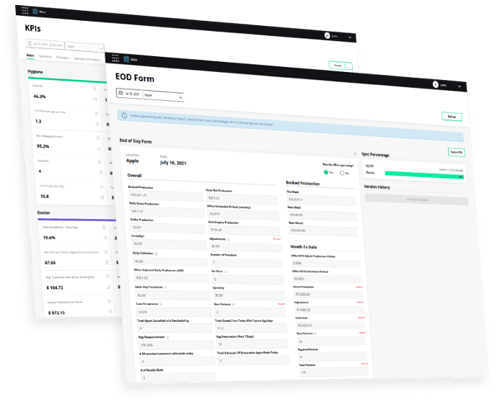As a dental office manager, dentist, or dental professional, are you leveraging what is one of your most powerful resources? We’re talking about your dental practice data. Your patient and practice data provides a vast wealth of information from sources you already rely on daily.
This overview will introduce you to the use, value, and benefits you can expect from leveraging your dental practice data to make better decisions.

Understanding Data Analytics
Data analytics is the process of acquiring, analyzing, and utilizing a collection of information to reveal its insights and enhance related decision-making processes.
Practically speaking, this data applies to your patient records, your scheduling processes, your billing systems and more. Eighty-two percent of dental businesses don’t have a business intelligence platform to gain insights into their organization,1 making them vulnerable to competition and limited growth opportunities. Data-driven tools provide strategic insights into your dental practice trends that can enhance your operational efficiency and patient outcomes.
The Value of Data Analytics
Use data to enhance your patient care.
Patient care includes more than treatment itself, and additional factors contribute to your treatment planning and related procedures.
You can enhance your level of care by providing deeper insights into your patient demographics, medical histories, treatment preferences, and treatment outcomes. It also creates a more personalized care experience through tailored treatment plans—leading to increased satisfaction with your care standards.
Use data to streamline and refine your dental practice operations
Operational systems and daily workflows can be overwhelming. The ADA estimates that dental practices lose up to 10 percent of their potential revenue due to operational inefficiencies and missed opportunities, such as appointment cancellations and no-shows.2 Analytics tools mine your existing data and identify simple areas for improvement such as how you schedule appointments, your staff productivity and workflow execution, inventory management and resource allocation, and financials.
As a dental office manager, analytics can assist you with identifying bottlenecks and team inefficiencies—as well as with designing relevant improvements.
While practice management systems often include basic analytics features, such as revenue reporting and appointment tracking, data-driven dental software solutions provide more advanced analytics capabilities, such as predictive modeling and patient segmentation. They also provide standard reports much faster than practice management systems alone, streamlining workflows and saving significant time throughout your day.
Use data to enable more informed decisions
Delayed decisions can be costly, but so can ill-timed or uninformed decisions.
With analytics tools, you can assess your data. This can provide useful and timely insight into your decision-making process, including guidance about practice management, marketing strategies, and financial and resource investments.
The Practical and Profitable Benefits of Data Analytics
A dialed-in patient experience
Analytics help answer the core questions about the patient experience: their preferences, their response to treatment plans, follow-up care, financial and insurance matters, marketing, and their overall satisfaction.
This knowledge enables you to create customized services and targeted marketing initiatives, leading to increased patient retention and acquisition.
A proactive risk management strategy
Data is your risk-management catalyst to identify and reduce risk potential, pinpoint billing errors before submission, stay current with compliance requirements, and maintain awareness about patient dissatisfaction.
A financial optimization opportunity
By analyzing your data, you can gain profitable insights into expenses, revenue streams, and resource allocation, including spending trends, resource inefficiencies, and cost-saving opportunities. A survey by Healthcare Business & Technology found that 85 percent of health care organizations, including dental practices, have experienced a positive impact on revenue after adopting analytics solutions.3
A more intuitive path for dental marketing and growth
Insights are essential to a compelling dental marketing plan and growth strategies, and the data you already collect is an insightful tool you can use to optimize and understand patient acquisition and retention, patient referrals and reviews, and patient demographics.
The Most Complete Dental Analytics Platform

By leveraging data and analytics tools, like Jarvis Analytics, you can address industry challenges head-on, significantly reducing administrative burdens, optimizing revenue, and making data-driven decisions to improve overall practice performance.
With Jarvis Analytics, dental practices can stay ahead of the competition and enhance the patient experience through efficient operations and improved insights.
Looking for more information about what Jarvis Analytics can do for you and your dental practice?

1. Jarvis Analytics. (2023). The State of the Business: Dental Industry Benchmark Report
2. American Dental Association (ADA). (2019). The state of the dental workforce: 2019. https://www.ada.org/resources/research/health-policy-institute/dentist-workforce
3. McKinsey & Company. (2018, December). Catch them if you can: How leaders in data and analytics have pulled ahead. https://www.mckinsey.com/capabilities/quantumblack/our-insights/catch-them-if-you-can-how-leaders-in-data-and-analytics-have-pulled-ahead